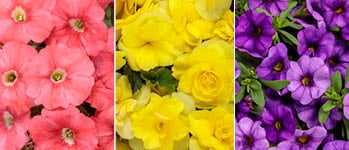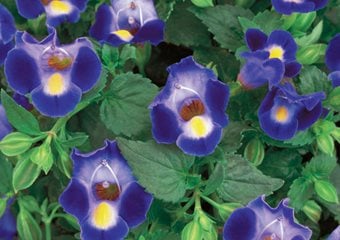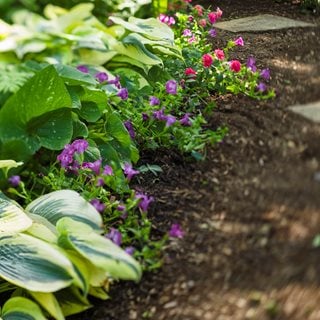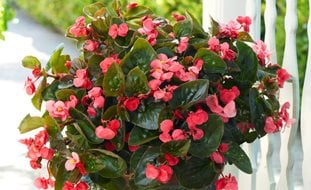How to Grow & Care for Wishbone Flower (Torenia)
Torenia plants are easy-care bloomers that put on a colorful display all season long.Do you love pansies but get frustrated when they fizzle out once the heat of summer arrives? If so, then wishbone flower (Torenia fournieri) is a great alternative. Bearing loads of cheery flowers reminiscent of pansies -- and in many of the same colors -- this shade-tolerant annual blooms nonstop from late spring through fall, even during the hottest days of summer.
Most torenia plants grow into tidy mounds perfect for use as an edging or filler for shady beds and borders. But you can also find trailing types (such as the Summer Wave® series) that work especially well in hanging baskets and window boxes. Many of the newer hybrids are also more tolerant of heat, humidity, and drought than older varieties, making them top performers in a wide range of climates.
On this page: Basics | Planting | Care | Varieties | Frequently Asked Questions
BASICS
Botanical name:
Torenia fournieri and hybrids
Common names:
Wishbone flower, torenia, clown flower, summer pansy, bluewings
Plant type:
Tender perennial (usually grown as an annual)
Zones:
Usually grown as an annual, may overwinter in Zones 10-11
Exposure:
Partial shade to full shade
Habit:
Upright or trailing
Height/spread:
8 to 16 inches tall and 8 to 10 inches wide. Trailing types may grow up to 36 inches in length.
Bloom time:
From late spring through the first frost
Flowers:
Trumpet-shaped flowers bloom in blue, purple, pink, white, yellow, and various bicolors, often with contrasting throats.
Special attributes:
- Attracts hummingbirds
- Needs no deadheading
- Good for cut flower arrangements
- Tolerates heat and humidity
- Deer resistant
Fun fact:
Why the common name wishbone flower? If you peer into the flower’s throat when it first opens, you’ll see two curved stamens that come together from opposite sides to form a shape like a tiny chicken wishbone.
HOW TO PLANT TORENIA
When to plant:
In spring, after the threat of frost has passed.
Where to plant:
For the best performance, choose a site that receives light to moderate shade. Plants can take more sun in cool Northern gardens. Although wishbone flower can also be grown in deep shade, it won’t flower as profusely.
How to plant:
Plant in rich, loamy soil that provides good drainage. In heavy clay soils, work some compost or other organic matter into the ground before planting. For mass plantings, space plants about 8 to 10 inches apart to allow for adequate air circulation.
When planting wishbone flower in containers, select a pot with holes for good drainage and fill with a free-draining soilless potting mix.
Growing from seed:
Most newer Torenia hybrids are sterile, but you can still purchase seed for some varieties (such as the Kauai™ series). In cool climates, start the seeds indoors 8 to 10 weeks before the last average frost date, planting them in biodegradable pots that you can easily pop into the garden.
Because the seeds need light to germinate, don’t cover them with soil. The seeds will germinate in about 2 to 3 weeks when kept in a warm room (around 70° F) and in evenly moist soil. In frost-free climates, you can sow the seeds directly in the garden in spring by pressing them gently into moist soil.
Learn more about growing plants from seed.
TORENIA CARE
Watering:
Wishbone flowers like consistently moist (but not soggy) conditions, so it’s best to water whenever the top inch of soil feels dry to the touch. To help retain moisture, amend the soil with organic matter and apply a layer of mulch. If planted in pots, wishbone flowers may need to be watered daily during hot, dry weather. To prevent mildew problems, keep the foliage dry by watering at ground level or by using a soaker hose.
Fertilizing:
To keep wishbone flower blooming vigorously throughout the summer, apply compost or a slow-release granular fertilizer at planting time. For plants growing in containers, fertilize every few weeks using a balanced water-soluble plant food.
Pruning and deadheading:
Although pruning isn’t necessary, you can shear plants back by about half to encourage bushier growth if they become to leggy. They will respond quickly with a new flush of blooms. Wishbone flowers are self-cleaning, sparing you the chore of deadheading.
Pests and diseases:
Can be susceptible to fungal diseases, such as powdery mildew and root rot, especially when overwatered. Also be on the lookout for common garden pests, particularly aphids and whiteflies.
TORENIA VARIETIES
FREQUENTLY ASKED QUESTIONS
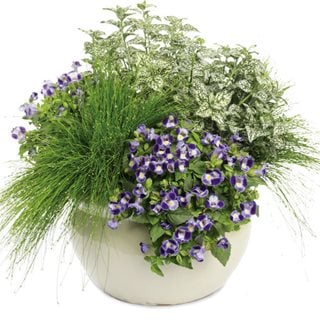
Heaven Sent container recipe with Catalina® Midnight Blue torenia.
Photo by: Proven Winners.
Is wishbone flower invasive?
Torenia (with the exception of sterile hybrids) will sometimes self-sow under ideal conditions, but are not considered to be invasive.
Can you grow torenia in full sun?
Torenia can adapt to full sun, especially when kept well-watered. However, in warmer climates, they will grow best when given morning sun and afternoon shade.
How do you keep torenia blooming?
Wishbone flower is a repeat bloomer and requires very little effort to keep the blooms coming. If your plant has stopped flowering, it may not be getting enough light, water, or fertilization.
Does torenia come back every year?
In zones 10-11, where winters are mild, wishbone flower is a perennial and can be grown outdoors year-round. In colder climates, the plant must be grown as an annual because it will not survive exposure to frost.
What are good companion plants for wishbone flower?
In container plantings, torenias pair beautifully with many different shade-tolerant annuals, including lobelia, coleus, creeping Jenny, impatiens, wax begonias, and Diamond Frost® euphorbia. Or try this eye-catching container recipe from Proven Winners (pictured), combining a dark blue wishbone flower with polka dot plant and fiber optic grass.
To liven up a shady garden bed, consider planting several varieties of wishbone flower in different colors, mixing them among your hostas, ferns, astilbes, and other shade-loving plants.
